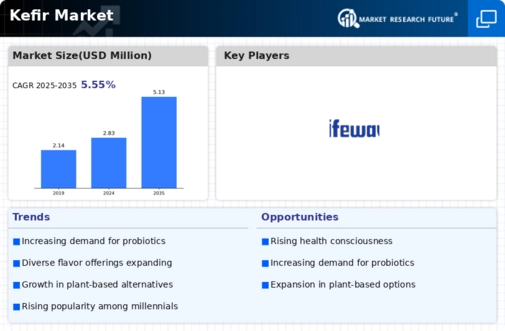Top Industry Leaders in the Kefir Market
 The kefir market, propelled by the increasing consumer focus on gut health and probiotic-rich foods, has become a significant segment within the dairy industry. As we explore the competitive landscape of the kefir market, it's essential to delve into the strategies adopted by key players, factors influencing market share, the emergence of new companies, industry news, prevalent investment trends, the overall competitive scenario, and notable developments in 2023.
The kefir market, propelled by the increasing consumer focus on gut health and probiotic-rich foods, has become a significant segment within the dairy industry. As we explore the competitive landscape of the kefir market, it's essential to delve into the strategies adopted by key players, factors influencing market share, the emergence of new companies, industry news, prevalent investment trends, the overall competitive scenario, and notable developments in 2023.
Leading the kefir market are key players such as
- Fresh Made Dairy
- Lifeway Foods Inc.
- Nestle SA
- The Hain Celestial Group Inc.
- Danone S.A.
These companies have established themselves as industry leaders through their extensive distribution networks, strong brand recognition, and diverse product portfolios. Lifeway Foods, for instance, has positioned itself as a pioneer in kefir production, offering a wide range of flavors and variations to cater to diverse consumer preferences.
Strategies Adopted
Key players in the kefir market employ strategies ranging from product diversification to marketing initiatives aimed at educating consumers about the health benefits of kefir. Lifeway Foods, for example, focuses on innovation by introducing new flavors and formulations, maintaining a competitive edge in a market where consumer preferences continually evolve. Strategic partnerships and acquisitions, such as Hain Celestial's acquisition of a kefir producer, are also employed to strengthen market presence and diversify product portfolios.
Factors for Market Share Analysis
Market share in the kefir industry is influenced by several factors. Product quality, taste preferences, brand loyalty, pricing strategies, and effective distribution channels play critical roles in determining a company's share of the market. The ability to adapt to evolving consumer preferences and meet regulatory standards for quality and safety are also pivotal factors.
New and Emerging Companies
While established players dominate the kefir market, there has been a noticeable influx of new and emerging companies. These entities often focus on niche segments, such as plant-based kefir or unique flavor combinations. The rise of these new players adds dynamism to the market, fostering innovation and addressing the diverse needs of health-conscious consumers.
Industry News and Current Company Updates
Recent news in the kefir market highlights a growing emphasis on sustainable and eco-friendly packaging. Key players are exploring options to reduce their environmental footprint, responding to the increasing consumer demand for eco-conscious products. Additionally, there has been a surge in marketing campaigns promoting kefir's health benefits, with companies investing in initiatives to educate consumers about the positive impact of probiotics on digestive health.
Investment Trends
Investment trends in the kefir market revolve around technological advancements, sustainability, and market expansion. Companies are investing in research and development to enhance production processes and extend the shelf life of kefir products. Sustainable packaging solutions, such as recyclable materials, are gaining traction as consumers become more environmentally conscious. Furthermore, investments in marketing and distribution channels are prevalent as companies aim to reach a broader consumer base.
Overall Competitive Scenario
The kefir market is characterized by intense competition, with both established and emerging players vying for market share. Differentiation strategies, such as the introduction of innovative flavors, variations, and packaging, are employed to stand out in a crowded market. Moreover, the global nature of the industry necessitates a keen understanding of regional preferences and cultural nuances, making it imperative for companies to tailor their strategies for different markets.
Recent Development
A notable development in the kefir market was the increased focus on functional attributes. Companies began emphasizing not only the probiotic content but also additional health benefits associated with specific strains of bacteria used in their kefir products. This trend reflects an evolving consumer mindset, where individuals seek products that offer holistic wellness beyond basic nutritional elements.
Furthermore, there was a surge in the development of non-dairy kefir alternatives to cater to the growing demand for plant-based options. Companies responded by utilizing ingredients like coconut, almond, or soy to create dairy-free kefir alternatives, acknowledging the increasing popularity of plant-based diets.
In terms of market consolidation, there were strategic mergers and acquisitions aimed at strengthening the market position of key players. These moves facilitated access to new markets and diversified product offerings. Such developments underscore the industry's pursuit of growth and resilience amid changing consumer preferences.










